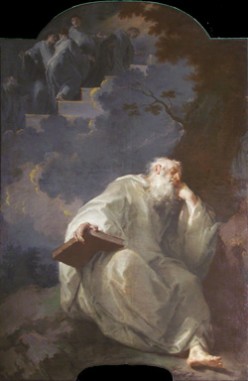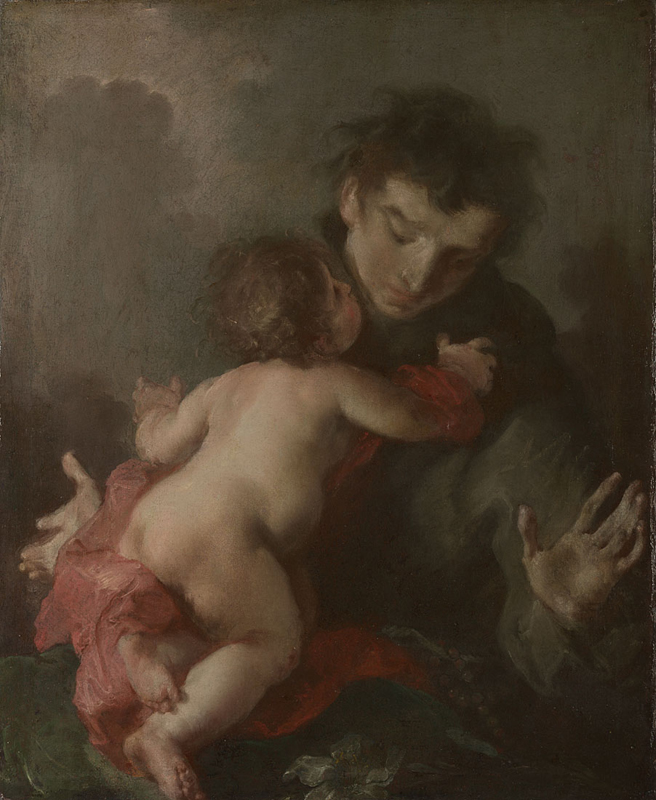Giuseppe Bazzani on:
[Wikipedia]
[Google]
[Amazon]
Giuseppe Bazzani (23 September 1690 – 17 August 1769) was an Italian painter of the
Encyclopedia Treccani
Dizionario Biografico degli Italiani - Volume 28 (1983), entry by Ksenija Rozman.



biography on Bazzani.
Rococo
Rococo (, also ), less commonly Roccoco or Late Baroque, is an exceptionally ornamental and theatrical style of architecture, art and decoration which combines asymmetry, scrolling curves, gilding, white and pastel colours, sculpted moulding, ...
.
Biography
Born inMantua
Mantua ( ; it, Mantova ; Lombard language, Lombard and la, Mantua) is a city and ''comune'' in Lombardy, Italy, and capital of the Province of Mantua, province of the same name.
In 2016, Mantua was designated as the Italian Capital of Culture ...
to a goldsmith
A goldsmith is a Metalworking, metalworker who specializes in working with gold and other precious metals. Nowadays they mainly specialize in jewelry-making but historically, goldsmiths have also made cutlery, silverware, platter (dishware), pl ...
, Giovanni Bazzani, early on he apprenticed with the Parmesan
Parmesan ( it, Parmigiano Reggiano; ) is an Italian hard, granular cheese produced from cows’ milk and aged at least 12 months.
It is named after two of the areas which produce it, the provinces of Parma and Reggio Emilia (''Parmigiano'' is ...
painter Giovanni Canti
Giovanni Canti (ca. 1650–1716) was an Italian painter of the Baroque. Born in Parma. Active in early 18th century. Among his pupils were Giuseppe Bazzani and Francesco Maria Raineri. He resided chiefly at Mantua
Mantua ( ; it, Mantova ; L ...
(1653–1715). A fellow pupil was Francesco Maria Raineri
Francesco Maria Raineri (2 February 1676 – 28 February 1758) was an Italian painter of the late-Baroque, mainly active in Mantua.
Biography
Also called ''Lo Schivenoglia'' after the town, just outside the city of Mantua, of his birth. He ...
. He spent most of his life in Mantua. From 1752, he was faculty, and from 1767, director of the ''Accademia di Belle Arti'' of Mantua.
While ensconced in a declining provincial city, he absorbed international influences. His loose brushstrokes, fervid and often dark emotionalism, and tortured poses, which recall at times later expressionism
Expressionism is a modernist movement, initially in poetry and painting, originating in Northern Europe around the beginning of the 20th century. Its typical trait is to present the world solely from a subjective perspective, distorting it rad ...
, display stylistic tendencies more typical of Lombardy
Lombardy ( it, Lombardia, Lombard language, Lombard: ''Lombardia'' or ''Lumbardia' '') is an administrative regions of Italy, region of Italy that covers ; it is located in the northern-central part of the country and has a population of about 10 ...
. Numerous artists, including Fetti
''Fetti'' is a collaborative studio album by American rappers Curren$y and Freddie Gibbs and record producer The Alchemist. It was released on October 31, 2018 for streaming and digital download by Jet Life Recordings, ESGN Records and ALC Recor ...
, Bencovich, Rubens, and Magnasco are said to have influenced him, although the number and diversity of the artists suggested hints that he had an idiosyncratic and unique synthesis for his time.
Among his early works are paintings of the ''Miracles of Pius V
Pope Pius V ( it, Pio V; 17 January 1504 – 1 May 1572), born Antonio Ghislieri (from 1518 called Michele Ghislieri, O.P.), was head of the Catholic Church and ruler of the Papal States from 8 January 1566 to his death in May 1572. He is v ...
'', the ''Conversion of a Heretic'' and the ''Healing of a Madwoman'' (all mid-1720s; Mantua, Museum of the Ducal Palace of Mantua
The Palazzo Ducale di Mantova ("Ducal Palace") is a group of buildings in Mantua, Lombardy, northern Italy, built between the 14th and the 17th century mainly by the noble family of House of Gonzaga, Gonzaga as their royal residence in the capita ...
), initially painted for the church of Saint Maurice
Saint Maurice (also Moritz, Morris, or Mauritius; ) was an Egyptians, Egyptian military leader who headed the legendary Theban Legion of Roman Empire, Rome in the 3rd century, and is one of the favorite and most widely venerated saints of that Ma ...
in Mantua. He painted depictions of the evangelists St. John, St. Mark and St. Luke
Luke the Evangelist (Latin: '' Lucas''; grc, Λουκᾶς, '' Loukâs''; he, לוקאס, ''Lūqās''; arc, /ܠܘܩܐ לוקא, ''Lūqā’; Ge'ez: ሉቃስ'') is one of the Four Evangelists—the four traditionally ascribed authors of t ...
(all late 1720s) for the parish church of Vasto di Goito. He painted the ''Baptism'', the ''Ecstasy of St. Aloysius Gonzaga
Aloysius de Gonzaga ( it, Luigi Gonzaga; 9 March 156821 June 1591) was an Italian aristocrat who became a member of the Society of Jesus. While still a student at the Roman College, he died as a result of caring for the victims of a serious epid ...
'' and the ''Ecstasy of Saints Francis & Anthony'' (1732) for the parish church of Borgoforte. Seven canvases depicting the Life of Alexander the Great
Alexander III of Macedon ( grc, wikt:Ἀλέξανδρος, Ἀλέξανδρος, Alexandros; 20/21 July 356 BC – 10/11 June 323 BC), commonly known as Alexander the Great, was a king of the Ancient Greece, ancient Greek kingdom of Maced ...
were painted for Giacomo Biondi, one of the artist's early patrons. His altarpiece of ''St Romuald's Vision'', initially painted for the church of San Marco, but now in Diocesan Museum of Mantua
Mantua ( ; it, Mantova ; Lombard language, Lombard and la, Mantua) is a city and ''comune'' in Lombardy, Italy, and capital of the Province of Mantua, province of the same name.
In 2016, Mantua was designated as the Italian Capital of Culture ...
, the saint, book in hand, has a dream in which he sees his fellow Benedictine monks ascending to heaven in a clumsy, touching, human parade up a staircase instead of a mystical Jacob's ladder. The painting merges a mixture of mystical vision and stylized empiric observation. The nineteenth-century art historian Carlo D'Arco was unconvinced about this brash new style, and said of Bazzani's work that "(he) wanted always to always use a great force of genius ...and most of his works appear as if unperfected sketches and immature conceptions that are drowning and convulsing in mannered styles."
The painter Domenico Conti Bazzani
Domenico Maria Conti or Conti Bazzani (or Bazzano/Bozani) (Mantua, 1740 - Rome, 19 February 1815) was an Italian painter, bridging Rococo and Neoclassical styles. He is described as a disciple, and adoptive son of Giuseppe Bazzani, who was dire ...
(1740–1815) was his pupil and adopted son, and became a prominent Neoclassical painter in Rome.Dizionario Biografico degli Italiani - Volume 28 (1983), entry by Ksenija Rozman.




References
* * *biography on Bazzani.
Anthology
{{DEFAULTSORT:Bazzani, Giuseppe 1690 births 1769 deaths 17th-century Italian painters Italian male painters 18th-century Italian painters Painters from Mantua Italian Baroque painters Rococo painters Catholic painters 18th-century Italian male artists